Research
-
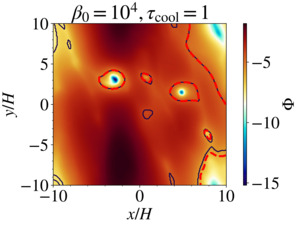
DISK FRAGMENTATION WITH MRI
Magnetic fields have always been thought of as a stabilizing agent against gravitational collapse through the pressure forces they exert. However, early works by Lynden-Bell (1966) suggested that magnetic fields can be a destabilizing agent in a rotating disk as magnetic tension can resist expansion by Coriolis forces, provided some large scale radial field is present. This work hypothesizes that MRI can generate such fields when a strong vertical flux is present, which can enhance gravitational collapse and promote clump formation. However, competing effects from magnetic elevation renders this effect subdominant.
Submitted to MNRAS. Not uploaded to Arxiv yet, contact me for a submitted draft.
-

DISSIPATION AT JET-WIND BOUNDARIES
Velocity and magnetic shears are prevalent at AGN jet-wind boundaries, which can trigger multiple types of instabilities. The dissipative effects when two or more types of instabilities occur concurrently are unclear. This work is a pioneering study assessing such effects when the Kelvin-Helmholtz instability, a fluid instability, interacts with the Drift-Kink instability, a kinetic instability. Our work shows that the two instabilities can synergistically enhance the dissipation by expanding the region for which particle acceleration can occur and enhancing the magnitude of the accelerating electic field each particle experiences. This work shows that mulitiple acting instabilities can have a huge effect on the dissipation, hence the luminosities observed at AGN jet-wind environments.
In prep for JPP.
-
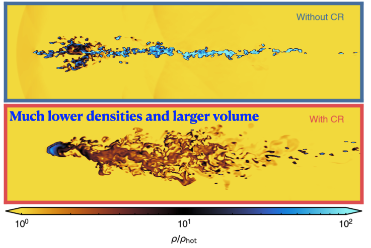
COSMIC RAY MODIFIED RADIATIVE TURBULENT MIXING LAYERS
It is well known that Cosmic Rays (CRs) can exert pressure forces and Alfvenic heating on galactic gases through the magnetic turbulence they excite. At the turbulent mixing layers between cold clouds and the hot ambient gas in the Circumgalactic Medium (CGM), CR pressure can significantly lower the temperature and density of the gas, thereby lowering the local, volumetric radiative luminosity. However, the substantial expansion of the mixing layers due to CR pressure compensates for this by allowing more gas to radiate, with the result that the overall luminosities of a cloud with and without CRs being roughly equal. This work examines the reason behind this conincidence. It appears not quite possible to distinguish the CR content in a cold cloud solely based on its overall luminosity.
Work in progress.
-
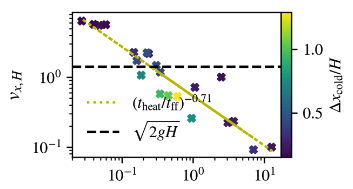
STABILITY OF GALACTIC HALOS WITH COSMIC RAY HEATING
Cosmic rays (CR) are believed to be an important ingredient in galactic feedback and regulation of the gas dynamics in the Circumgalactic Medium (CGM). CRs can excite magnetic turbulence and through it exert pressure forces and Alfvenic heating on galactic gases. In a stratified, thermally unstable environment, the mass drawn out by the cold clouds causes their surroundings to be rarefied, making them susceptible to a thermally driven wind by CR heating. This work examines the different kind of winds that can be driven in terms of the ratio of the CR heating time over the free-fall time t_CR/t_ff, and the ratio of the CR pressure over gas pressure at the disk.
Click image or here to access the ADS link to the paper.
-
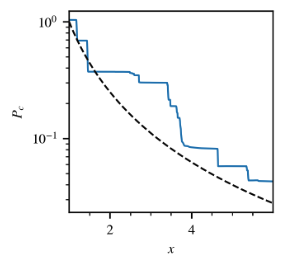
COSMIC RAY DRIVEN ACOUSTIC INSTABILITY
Cosmic rays (CR) can excite magnetic turbulence and through it exert pressure forces and Alfvenic heating on galactic gases. This interaction can destabilize sound waves provided the magnetic field is strong enough such that plasma beta is roughly less than 0.5. This work examines the linear growth of such instability and the nonlinear outcome. It was found that a curious structure, characterized by a staircase like profile in the CR pressure and shocks develop in the nonlinear regime that could impact the overall compressibility of the gas and create an effective oppacity for the CRs which could drive stronger winds.
Click image or here to access the ADS link to the paper.
-
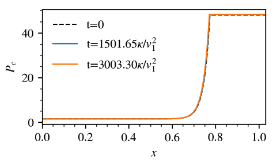
COSMIC RAY MODIFIED FLUID SHOCKS
Cosmic rays (CR) can excite magnetic turbulence and through it exert pressure forces and Alfvenic heating on galactic gases. This interaction substantially modifies the structure of shocks. Instead of being a discontinuity, shocks now have an extended presursor and postcursor. This work describes in detail the solutions to the CR modified fluid shock equations, and shows that the recently developed CR-MHD fluid solver (Jiang & Oh 2018) can accurately capture such solutions.
Click image or here to access the ADS link to the paper.
